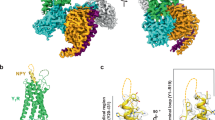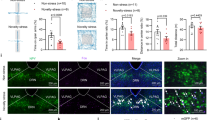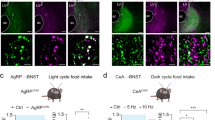Abstract
Converging evidence implicates the regulatory neuropeptide Y (NPY) in anxiety- and depression-related behaviors. The present study sought to assess whether there is an association between the magnitude of behavioral responses to stress and patterns of NPY in selected brain areas, and subsequently, whether pharmacological manipulations of NPY levels affect behavior in an animal model of PTSD. Animals were exposed to predator-scent stress for 15 min. Behaviors were assessed with the elevated plus maze and acoustic startle response tests 7 days later. Preset cutoff criteria classified exposed animals according to their individual behavioral responses. NPY protein levels were assessed in specific brain regions 8 days after the exposure. The behavioral effects of NPY agonist, NPY-Y1-receptor antagonist, or placebo administered centrally 1 h post-exposure were evaluated in the same manner. Immunohistochemical technique was used to detect the expression of the NPY, NPY-Y1 receptor, brain-derived neurotrophic factor, and GR 1 day after the behavioral tests. Animals whose behavior was extremely disrupted (EBR) selectively displayed significant downregulation of NPY in the hippocampus, periaqueductal gray, and amygdala, compared with animals whose behavior was minimally (MBR) or partially (PBR) disrupted, and with unexposed controls. One-hour post-exposure treatment with NPY significantly reduced prevalence rates of EBR and reduced trauma-cue freezing responses, compared with vehicle controls. The distinctive pattern of NPY downregulation that correlated with EBR as well as the resounding behavioral effects of pharmacological manipulation of NPY indicates an intimate association between NPY and behavioral responses to stress, and potentially between molecular and psychopathological processes, which underlie the observed changes in behavior. The protective qualities attributed to NPY are supported by the extreme reduction of its expression in animals severely affected by the stressor and imply a role in promoting resilience and/or recovery.
Similar content being viewed by others
Log in or create a free account to read this content
Gain free access to this article, as well as selected content from this journal and more on nature.com
or
References
Bannon AW, Seda J, Carmouche M, Francis JM, Norman MH, Karbon B et al (2000). Behavioral characterization of neuropeptide Y knockout mice. Brain Res 868: 79–87.
Barnea A, Roberts J (2001). Induction of functional and morphological expression of neuropeptide Y (NPY) in cortical cultures by brain-derived neurotrophic factor (BDNF): evidence for a requirement for extracellular-regulated kinase (ERK)-dependent and ERK-independent mechanisms. Brain Res 919: 57–69.
Beck B (2000). Neuropeptides and obesity. Nutrition 16: 916–923.
Bramham C, Messaoudi E (2005). BDNF function in adult synaptic plasticity: the synaptic consolidation hypothesis. Prog Neurobiol 76: 99–125.
Britton K, Akwa Y, Spina M, Koob G (2000). Neuropeptide Y blocks anxiogenic-like behavioral action of corticotropin-releasing factor in an operant conflict test and elevated plus maze. Peptides 21: 37–44.
Britton K, Southerland S, Van Uden E, Kirby D, Rivier J, Koob G (1997). Anxiolytic activity of NPY receptor agonists in the conflict test. Psychopharmacology 1325: 6–13.
Broqua P, Wettstein J, Rocher M, Gauthier-Martin B, Junien J (1995). Behavioral effects of neuropeptide Y receptor agonists in the elevated plus-maze and fear potentiated startle procedures. Behav Pharmacol 6: 215–222.
Caberlotto L, Fuxe K, Overstreet D, Gerrard P, Hurd Y (1998). Alterations in neuropeptide Y, Y1 receptor mRNA expression in brains from an animal model of depression: Region specific adaptation after fluoxetine treatment. Mol Brain Res 59: 58–65.
Clark JT, Kalra PS, Kalra SP (1985). Neuropeptide Y stimulates feeding but inhibits sexual behavior in rats. Endocrinology 117: 2435–2442.
Cohen H, Kaplan Z, Matar MA, Loewenthal U, Zohar J, Richter-Levin G (2008a). Long-lasting behavioral effects of juvenile trauma in an animal model of PTSD associated with a failure of the autonomic nervous system to recover. Eur Neuropsychopharmacol 17: 464–477.
Cohen H, Kozlovsky N, Matar MA, Zohar J, Kaplan Z (2011). The characteristic long-term upregulation of hippocampal NF-kappaB complex in PTSD-like behavioral stress response is normalized by high-dose corticosterone and pyrrolidine dithiocarbamate administered immediately after exposure. Neuropsychopharmacology 36: 2286–2302.
Cohen H, Matar MA, Buskila D, Kaplan Z, Zohar J (2008b). Early post-stressor intervention with high-dose corticosterone attenuates posttraumatic stress response in an animal model of posttraumatic stress disorder. Biol Psychiatry 64: 708–717.
Cohen H, Zohar J (2004). An animal model of posttraumatic stress disorder: the use of cut-off behavioral criteria. Ann NY Acad Sci 1032: 167–178.
Cohen H, Zohar J, Gidron Y, Matar MA, Belkind D, Loewenthal U et al (2006). Blunted HPA axis response to stress influences susceptibility to posttraumatic stress response in rats. Biol Psychiatry 59: 1208–1218.
Cohen H, Zohar J, Matar M (2003). The relevance of differential response to trauma in an animal model of post-traumatic stress disorder. Biol Psychiatry 15: 463–473.
Cohen H, Zohar J, Matar M, Loewenthal U, Kaplan Z (2007). The impact of environment factors in determining post-exposure responses in isogenic strains of mice: can genetic predisposition explain phenotypic vulnerability? Int J Neuropsychopharmacol 11: 331–349.
Cohen H, Zohar J, Matar MA, Kaplan Z, Geva AB (2005). Unsupervised fuzzy clustering analysis supports behavioral cutoff criteria in an animal model of posttraumatic stress disorder. Biol Psychiatry 58: 640–650.
Cohen H, Zohar J, Matar MA, Zeev K, Loewenthal U, Richter-Levin G (2004). Setting apart the affected: the use of behavioral criteria in animal models of post traumatic stress disorder. Neuropsychopharmacology 29: 1962–1970.
Colmers WF, Bleakman D (1994). Effects of neuropeptide Y on the electrical properties of neurons. Trends Neurosci 17: 373–379.
Croce N, Dinallo V, Ricci V, Federici G, Caltagirone C, Bernardini S et al (2011). Neuroprotective effect of neuropeptide Y against beta-amyloid 25–35 toxicity in SH-SY5Y neuroblastoma cells is associated with increased neurotrophin production. Neurodegener Dis 8: 300–309.
de Quidt ME, Emson PC (1986). Distribution of neuropeptide Y-like immunoreactivity in the rat central nervous system-II. Immunohistochemical analysis. Neuroscience 18: 545–618.
Decressac M, Wright B, David B, Tyers P, Jaber M, Barker RA et al (2010). Exogenous neuropeptide Y promotes in vivo hippocampal neurogenesis. Hippocampus (e-pub ahead of print, 21 January 2010).
Domschke K, Dannlowski U, Hohoff C, Ohrmann P, Bauer J, Kugel H et al (2010). Neuropeptide Y (NPY) gene: impact on emotional processing and treatment response in anxious depression. Eur Neuropsychopharmacol 20: 301–309.
Ehlers CL, Li TK, Lumeng L, Hwang BH, Somes C, Jimenez P et al (1998). Neuropeptide Y levels in ethanol-naive alcohol-preferring and nonpreferring rats and in Wistar rats after ethanol exposure. Alcohol Clin Exp Res 22: 1778–1782.
File SE, Zangrossi Jr H, Sanders FL, Mabbutt PS (1993). Dissociation between behavioral and corticosterone responses on repeated exposures to cat odor. Physiol Behav 54: 1109–1111.
Flood JF, Hernandez EN, Morley JE. (1987). Modulation of memory processing by neuropeptide Y. Brain Res 421: 280–290.
Gehlert DR. (1999). Role of hypothalamic neuropeptide Y in feeding and obesity. Neuropeptides 33: 329–338.
Gelfo F, De Bartolo P, Tirassa P, Croce N, Caltagirone C, Petrosini L et al (2011). Intraperitoneal injection of neuropeptide Y (NPY) alters neurotrophin rat hypothalamic levels: implications for NPY potential role in stress-related disorders. Peptides 32: 1320–1323.
Goyal SN, Upadhya MA, Kokare DM, Bhisikar SM, Subhedar NK (2009). Neuropeptide Y modulates the antidepressant activity of imipramine in olfactory bulbectomized rats: involvement of NPY Y1 receptors. Brain Res 1266: 45–53.
Heilig M (2004). The NPY system in stress, anxiety and depression. Neuropeptides 38: 213–224.
Heilig M, Vecsei L, Widerlov E (1989). Opposite effects of centrally administered neuropeptide Y (NPY) on locomotor activity of spontaneously hypertensive (SH) and normal rats. Acta Physiol Scand 137: 243–248.
Heilig M, Widerlöv E (1995). Neurobiology and clinical aspects of neuropeptide Y. Crit Rev Neurobiol 9: 115–136.
Heilig M, Zachrisson O, Thorsell A, Ehnvall A, Mottagui-Tabar S, Sjogren M et al (2004). Decreased cerebrospinal fluid neuropeptide Y (NPY) in patients with treatment refractory unipolar major depression: preliminary evidence for association with preproNPY gene polymorphism. J Psychiatr Res 38: 113–121.
Howell OW, Silva S, Scharfman HE, Sosunov AA, Zaben M, Shatya A et al (2007). Neuropeptide Y is important for basal and seizure-induced precursor cell proliferation in the hippocampus. Neurobiol Dis 26: 174–188.
Huang EJ, Reichardt LF (2001). Neurotrophins: roles in neuronal development and function. Annu Rev Neurosci 24: 677–736.
Husum H, Aznar S, Hoyer-Hansen S, Larsen MH, Mikkelsen JD, Moller A et al (2006). Exacerbated loss of cell survival, neuropeptide Y-immunoreactive (IR) cells, and serotonin-IR fiber lengths in the dorsal hippocampus of the aged flinders sensitive line ‘depressed’ rat: Implications for the pathophysiology of depression? J Neurosci Res 84: 1292–1302.
Husum H, Mathé AA (2002). Early life stress changes concentrations of neuropeptide Y and corticotropin-releasing hormone in adult rat brain. Lithium treatment modifies these changes. Neuropsychopharmacology 27: 756–764.
Jimenez-Vasquez PA, Diaz-Cabiale Z, Caberlotto L, Bellido I, Overstreet D, Fuxe K et al (2007). Electroconvulsive stimuli selectively affect behavior and neuropeptide Y (NPY) and NPY Y(1) receptor gene expressions in hippocampus and hypothalamus of Flinders Sensitive Line rat model of depression. Eur Neuropsychopharmacol 17: 298–308.
Jimenez-Vasquez PA, Mathé AA, Thomas JD, Riley EP, Ehlers CL (2001). Early maternal separation alters neuropeptide Y concentrations in selected brain regions in adult rats. Brain Res Dev Brain Res 131: 149–152.
Jones KR, Farinas I, Backus C, Reichardt LF (1994). Targeted disruption of the BDNF gene perturbs brain and sensory neuron development but not motor neuron development. Cell 76: 989–999.
Kalra SP, Dube MG, Pu S, Xu B, Horvath TL (1999). Interacting appetite-regulating pathways in the hypothalamic regulation of body weight. Endocr Rev 20: 68–100.
Karlsson RM, Choe JS, Cameron HA, Thorsell A, Crawley JN, Holmes A et al (2008). The neuropeptide Y Y1 receptor subtype is necessary for the anxiolytic-like effects of neuropeptide Y, but not the antidepressant-like effects of fluoxetine, in mice. Psychopharmacology (Berl) 195: 547–557.
Kask A, Harro J, von Horsten S, Redrobe JP, Dumont Y, Quirion R (2002). The neurocircuitry and receptor subtypes mediating anxiolytic-like effects of neuropeptide Y. Neurosci Biobehav Rev 26: 259–283.
Kask A, Rago L, Harro J (1996). Anxiogenic-like effect of the neuropeptide Y Y1 receptor antagonist BIBP 3226: antagonism with diazepam. Eur J Pharmacol 317: R3–R4.
Kim JJ, Fanselow MS, DeCola JP, Landeira-Fernandez J (1992). Selective impairment of long-term but not short-term conditional fear by the N-methyl-D-aspartate antagonist APV. Behav Neurosci 106: 591–596.
Kopp J, Xu ZQ, Zhang X, Pedrazzini T, Herzog H, Kresse A et al (2002). Expression of the neuropeptide Y Y1 receptor in the CNS of rat and of wild-type and Y1 receptor knock-out mice. Focus on immunohistochemical localization. Neuroscience 111: 443–532.
Krysiak R, Obuchowicz E, Herman ZS (1999). Interactions between the neuropeptide Y system and the hypothalamic-pituitary-adrenal axis. Eur J Endocrinol 140: 130–136.
Mamounas LA, Altar CA, Blue ME, Kaplan DR, Tessarollo L, Lyons WE (2000). BDNF promotes the regenerative sprouting, but not survival, of injured serotonergic axons in the adult rat brain. J Neurosci 20: 771–782.
Mathé A (1999). Neuropeptides and electroconvulsive treatment. J ECT 15: 60–75.
Mathé A, Gruber S, Jiménesz P, Theodorsson E, Stenfors C (1997). Effect of electroconvulsive stimuli and MK-801 on neuropeptide Y, neurokinin A, calcitonin gene-related peptide in rat brain. Neurochem Res 22: 629–636.
Mathé A, Husum H, El Khoury A, Jiménez-Vasquez P, Gruber S, Wörtwein G et al (2007). Search for biological correlates of depression and mechanisms of action of antidepressant treatment modalities. Do neuropeptides play a role? Physiol Behav 92: 226–231.
Mathé A, Rudorfer M, Stenfors C, Manji H, Potter W, Theodorsson E (1996). Effects of electroconvulsive treatment on somatostatin, neuropeptide Y, endothelin and neurokinin A concentration in cerebrospinal fluid of depressed patients. Depression 3: 250–257.
Mazor A, Matar MA, Kaplan Z, Kozlovsky N, Zohar J, Cohen H (2007). Gender-related qualitative differences in baseline and post-stress anxiety responses are not reflected in the incidence of criterion-based PTSD-like behaviour patterns. World J Biol Psychiatry 10: 856–869.
Michel MC, Beck-Sickinger A, Cox H, Doods HN, Herzog H, Larhammar D et al (1998). International Union of Pharmacology recommendations for the nomenclature of neuropeptide Y, peptide YY, and pancreatic polypeptide receptors. Pharmacol Rev 50: 143–150.
Naert G, Ixart G, Maurice T, Tapia-Arancibia L, Givalois L (2011). Brain-derived neurotrophic factor and hypothalamic-pituitary-adrenal axis adaptation processes in a depressive-like state induced by chronic restraint stress. Mol Cell Neurosci 46: 55–66.
Nawa H, Bessho Y, Carnahan J, Nakanishi S, Mizuno K (1993). Regulation of neuropeptide expression in cultured cerebral cortical neurons by brain-derived neurotrophic factor. J Neurochem 60: 772–775.
Nawa H, Pelleymounter MA, Carnahan J (1994). Intraventricular administration of BDNF increases neuropeptide expression in newborn rat brain. J Neurosci 14: 3751–3765.
Neumann ID, Wegener G, Homberg JR, Cohen H, Slattery DA, Zohar J et al (2011). Animal models of depression and anxiety: what do they tell us about human condition? Prog Neuropsychopharmacol Biol Psychiatry 35: 1357–1375.
Nikisch G, Agren H, Eap CB, Czernik A, Baumann P, Mathe AA (2005). Neuropeptide Y and corticotropin-releasing hormone in CSF mark response to antidepressive treatment with citalopram. Int J Neuropsychopharmacol 8: 403–410.
Palmiter RD, Erickson JC, Hollopeter G, Baraban SC, Schwartz MW (1998). Life without neuropeptide Y. Recent Prog Horm Res 53: 163–199.
Paxinos G, Watson C (2005). The Rat Brain in Stereotaxic Coordinates, 5th edn. Elsevier Academic Press: Burlington, MA.
Pickens CL, Adams-Deutsch T, Nair SG, Navarre BM, Heilig M, Shaham Y (2009). Effect of pharmacological manipulations of neuropeptide Y and corticotropin-releasing factor neurotransmission on incubation of conditioned fear. Neuroscience 164: 1398–1406.
Poo MM (2001). Neurotrophins as synaptic modulators. Nat Rev Neurosci 2: 24–32.
Primeaux SD, Wilson SP, Cusick MC, York DA, Wilson MA (2005). Effects of altered amygdalar neuropeptide Y expression on anxiety-related behaviors. Neuropsychopharmacology 30: 1589–1597.
Rasmusson AM, Hauger RL, Morgan CA, Bremner JD, Charney DS, Southwick SM (2000). Low baseline and yohimbine-stimulated plasma neuropeptide Y (NPY) levels in combat-related PTSD. Biol Psychiatry 47: 526–539.
Redrobe JP, Dumont Y, St-Pierre JA, Quirion R (1999). Multiple receptors for neuropeptide Y in the hippocampus: putative roles in seizures and cognition. Brain Res 848: 153–166.
Sah R, Ekhator NN, Strawn JR, Sallee FR, Baker DG, Horn PS et al (2009). Low cerebrospinal fluid neuropeptide Y concentrations in posttraumatic stress disorder. Biol Psychiatry 66: 705–707.
Sajdyk TJ, Johnson PL, Leitermann RJ, Fitz SD, Dietrich A, Morin M et al (2008). Neuropeptide Y in the amygdala induces long-term resilience to stress-induced reductions in social responses but not hypothalamic-adrenal-pituitary axis activity or hyperthermia. J Neurosci 28: 893–903.
Sajdyk TJ, Vandergriff MG, Gehlert DR (1999). Amygdalar neuropeptide Y Y1 receptors mediate the anxiolytic-like actions of neuropeptide Y in the social interaction test. Eur J Pharmacol 368: 143–147.
Schmidt MV, Liebl C, Sterlemann V, Ganea K, Hartmann J, Harbich D et al (2008). Neuropeptide Y mediates the initial hypothalamic-pituitary-adrenal response to maternal separation in the neonatal mouse. J Endocrinol 197: 421–427.
Sergeyev V, Fetissov S, Mathe AA, Jimenez PA, Bartfai T, Mortas P et al (2005). Neuropeptide expression in rats exposed to chronic mild stresses. Psychopharmacology (Berl) 178: 115–124.
Shieh PB, Ghosh A (1999). Molecular mechanisms underlying activity-dependent regulation of BDNF expression. J Neurobiol 41: 127–134.
Small CJ, Morgan DG, Meeran K, Heath MM, Gunn I, Edwards CM et al (1997). Peptide analogue studies of the hypothalamic neuropeptide Y receptor mediating pituitary adrenocorticotrophic hormone release. Proc Natl Acad Sci USA 94: 11686–11691.
Stenfors C, Theodorsson E, Mathe AA (1989). Effect of repeated electroconvulsive treatment on regional concentrations of tachykinins, neurotensin, vasoactive intestinal polypeptide, neuropeptide Y, and galanin in rat brain. J Neurosci Res 24: 445–450.
Thoenen H (2000). Neurotrophins and activity-dependent plasticity. Prog Brain Res 128: 183–191.
Thorsell A, Michalkiewicz M, Dumont Y, Quirion R, Caberlotto L, Rimondini R et al (2000). Behavioral insensitivity to restraint stress, absent fear suppression of behavior and impaired spatial learning in transgenic rats with hippocampal neuropeptide Y overexpression. Proc Natl Acad Sci USA 97: 12852–12857.
Wahlestedt C, PiIch E, Koob G, Yee F, Heilig M (1993). Modulation of anxiety and neuropeptide Y-Y1 receptors by antisense oligodeoxynucleotides. Science 259: 528–531.
White J (1993). Neuropeptide Y: a central regulator of energy homeostasis. Regul Pept 49: 93–107.
Xapelli S, Bernardino L, Ferreira R, Grade S, Silva AP, Salgado JR et al (2008). Interaction between neuropeptide Y (NPY) and brain-derived neurotrophic factor in NPY-mediated neuroprotection against excitotoxicity: a role for microglia. Eur J Neurosci 27: 2089–2102.
Yehuda R, Brand S, Yang RK (2006). Plasma neuropeptide Y concentrations in combat exposed veterans: relationship to trauma exposure, recovery from PTSD, and coping. Biol Psychiatry 59: 660–663.
Acknowledgements
This study was supported by a grant from the National Institute for Psychobiology in Israel, funded by Charles E Smith Family, the Israel Academy of Science and Humanities (grant #429/03) and by the Ministry of Health (grant #6086) given to HC and the Swedish Medical Research Council grant 10414 and the Karolinska Institutet (AAM).
Author information
Authors and Affiliations
Corresponding authors
Ethics declarations
Competing interests
The authors declare no conflict of interest.
Rights and permissions
About this article
Cite this article
Cohen, H., Liu, T., Kozlovsky, N. et al. The Neuropeptide Y (NPY)-ergic System is Associated with Behavioral Resilience to Stress Exposure in an Animal Model of Post-Traumatic Stress Disorder. Neuropsychopharmacol 37, 350–363 (2012). https://doi.org/10.1038/npp.2011.230
Received:
Revised:
Accepted:
Published:
Issue date:
DOI: https://doi.org/10.1038/npp.2011.230
Keywords
This article is cited by
-
NAPE-PLD deletion in stress-TRAPed neurons results in an anxiogenic phenotype
Translational Psychiatry (2023)
-
Lateral hypothalamic proenkephalin neurons drive threat-induced overeating associated with a negative emotional state
Nature Communications (2023)
-
Association of Increased Amygdala Activity with Stress-Induced Anxiety but not Social Avoidance Behavior in Mice
Neuroscience Bulletin (2022)
-
Functional deletion of neuropeptide Y receptors type 2 in local synaptic networks of anteroventral BNST facilitates recall and increases return of fear
Molecular Psychiatry (2021)
-
Comparison of the Adaptive Capacity in Old and Young Wistar Rats to Stress Exposure and Acute Hypoxic Hypoxia
Bulletin of Experimental Biology and Medicine (2021)



